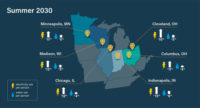A compressor design from Purdue University innovators proposes a new drive mechanism for compressors used for cooling in homes, buildings, airplanes, and cars.
The Purdue team created a new design to create the orbiting motion for scroll compressors, which are commonly used in cooling systems of different sizes. The new design relies on a gear mechanism to create the orbiting motion of a scroll wrap within another stationary scroll wrap to compress a refrigerant.
“In the conventional scroll compressor setup, typically an Oldham coupling is used, which is based on a metal to metal sliding contact,” said Leon Brendel, a Ph.D. student in mechanical engineering. “This causes frictional losses and requires complicated wear-in processes for the manufacturer. Our design is driven by a gear mechanism instead, aiming to reduce the overall friction to offer a more efficient compressor and simplify wear-in processes to reduce manufacturing cost.”
Other members of the design team include Eckhard Groll and James Braun, Purdue professors of mechanical engineering.
The Purdue orbiting scroll design is driven by a gear mechanism consisting of a center gear and three smaller gears surrounding and connected to the center gear. The smaller gears have off-centered anchor points to attach the base plate of the orbiting scroll.
“The mechanism also can be designed to define the orbit more accurately, thereby reducing leakage gaps, which could improve the compressor efficiency,” Brendel said.
The Purdue design moves any weight-balancing away from the center shaft to the three smaller gears, leading to a reduction of vibrations and potentially an increased maximum compressor speed.
Brendel said the Purdue compressor design has applications for cooling systems in residential homes, supermarkets, and other large buildings, trains, cars, and refrigerated trucks.
The design team is working with the Purdue Research Foundation Office of Technology Commercialization to license this patented technology. The office is now housed in the Convergence Center for Innovation and Collaboration in Discovery Park District, adjacent to the Purdue campus.
The researchers are looking for partners to continue developing their technology. For more information on licensing and other opportunities, contact Dhananjay Sewak of OTC at dsewak@prf.org and mention track code 2020-GROL-69101.





